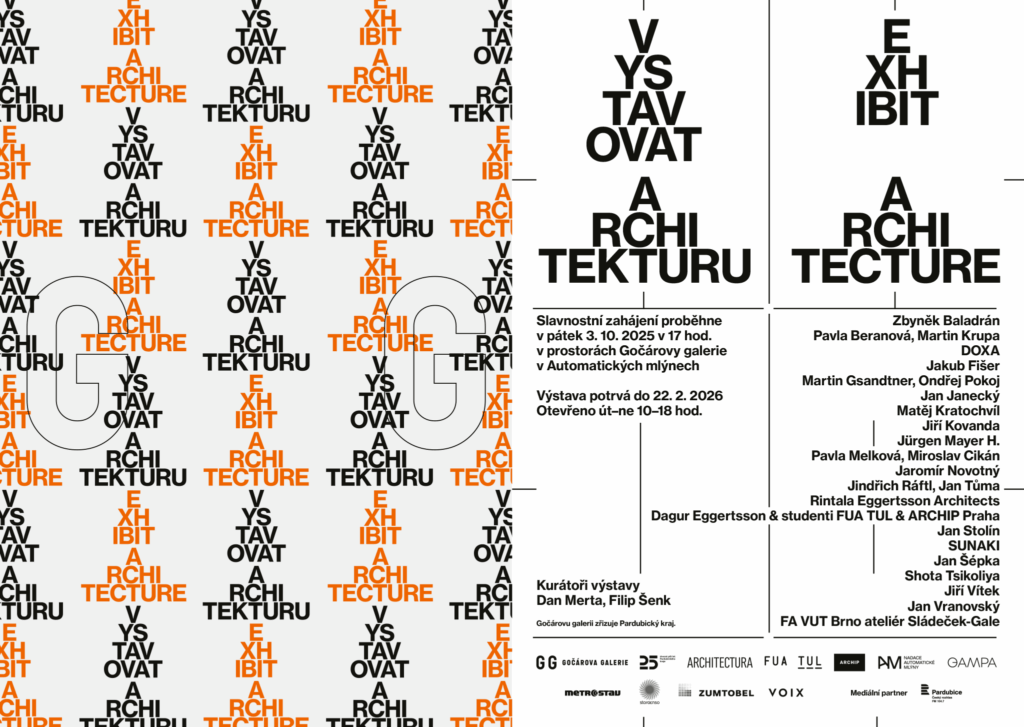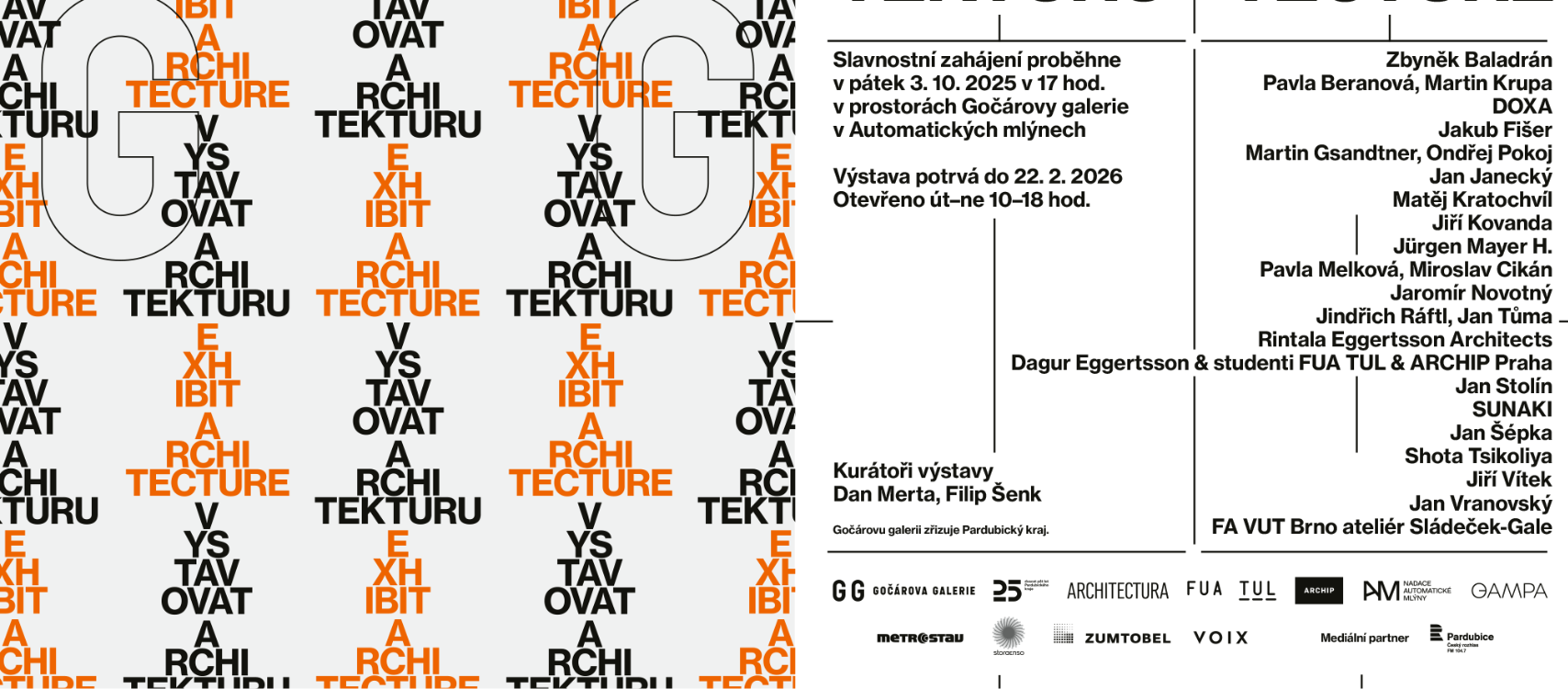4. 10. 2025 – 22. 2. 2026
organizers / Gočárova galerie, Fakulta umění a architektury Technické univerzity v Liberci, ARCHITECTURA
coorganizers / GAMPA, Nadace Automatické mlýny
main curator / Dan Merta
SILO section curator / Filip Šenk
exhibiting authors /
Zbyněk Baladrán, Pavla Beranová & Martin Krupa, COLLARCH & Architekti Šebo Lichý, DOXA, Jakub Fišer, Martin Gsandtner & Ondřej Pokoj, Jan Janecký, Matěj Kratochvíl, Jiří Kovanda, Jürgen Mayer H., MCA – Pavla Melková & Miroslav Cikán, Jaromír Novotný, JinJan – Jindřich Ráftl & Jan Tůma, Rintala Eggertsson Architects – Dagur Eggertsson & students of FUA TUL & ARCHIP Praha, Jan Stolín, SUNAKI – Toshikatsu Kiuchi & Taichi Sunayama, Jan Šépka, Jiří Vítek, Jan Vranovský, FA VUT Brno studio Svatopluk Sládeček – Nicol Gale
& artists whose works are represented in the Gočár Gallery collection /
Jindřich Hegr, Stanislav Kolíbal, Vladimír Kopecký, František Kyncl, Kamil Lhoták, Jaroslav Paur, Vladimír Preclík
production / Klára Pučerová, Jakub Semerád
graphic design / Milan Nedvěd
exhibition design / Iva Dvořáková, Jakub Fišer
text editing / Klára Pučerová, Jana Palacká
translation / Vít Zelinka
promotion / Nikola Kopecká, Cecílie Kutálková
education / Andrea Koláčková, Karolína Novotná, Hana Paulusová, Alžběta Štenclová, Anna Vitvarová
acknowledgements / Petr Kratochvíl, Irena Mertová, Eduard Seibert, Helena Vágnerová, Petra Valašteková, Petra Vlachynská, Tomáš Vlček
supported by / Metrostav, Stora Enso, Zumtobel, VOIX Audio & Cinema, ARCHIP Praha, FA VUT v Brně
The exhibition is under the patronage of Mr. Roman Línek, Councillor of the Pardubice Region for Culture. The Gočár Gallery is established by the Pardubice Region.
Is it even possible to exhibit architecture? It is possible to use technical or literary texts, plans, sketches, photographs, physical and digital models, visualizations, films and documents, audio recordings, light installations, haptic samples of materials, social and economic analyses, graphs, statistics, virtual or augmented reality to sufficiently convey to the viewer the information and emotions associated with experiencing architecture? These questions are answered by curators and prominent figures in the fields of architecture, urbanism, and visual arts at the Automatic Mills complex, which is associated with both an iconic figure of Czech architecture and renowned contemporary artists. Architectural historian Eeva-Liisa Pelkonen has described the effort to exhibit architecture as Sisyphean: “The ambition to exhibit architecture always carries with it a paradox: how to exhibit something as large and complex as a building or a city, and how to communicate something as elusive as the architectural experience that takes place in space and time?”Architecture, often referred to as the Mother of the Arts, not only has a functional role but also an ethical and aesthetic one. How can these fundamental functions be presented to gallery visitors? It is not sufficient to describe only the technical structure; it is necessary to find ways to convey the essential experience of a given place or building. Only then can we present it in its entirety and in the context of its anchoring in place and social ties. Does it even make sense to exhibit architecture in an age characterized by an overload of information of very varying quality? What are the main forms of exhibiting architecture? Strategies and themes in the field of architectural exhibitions are changing worldwide based on social needs, trends, and fashions, which can be regularly observed in the curatorial concepts of the premier exhibition, the Venice Architecture Biennale, as well as other international institutions dedicated to the presentation of architecture.
From the 1990s until the economic crisis of 2008, the celebration of economic growth continued, and exhibitions were based primarily on iconic buildings or the presentation of so-called starchitects. However, all of the crises of the new millennium, which we now see coming cyclically or transforming into a single long-term geopolitical, social, and environmental crisis of global proportions with various territorial hotspots, fundamentally permeate the concept of exhibitions on the theme of architecture. One can see a strong parallel with the 1960s. At that time, many art institutions, philosophers, artists, and architects used the medium of architectural exhibitions to discuss environmental and social issues caused by uncontrolled economic growth and the modernist approach after World War II. Central to contemporary multimedia visual culture is the intermingling of the worlds of fine art, architecture, and scenography, a mix of genres and media, and a call for multisensory art and architecture in the form of conceptual installations that evoke a special atmosphere for the viewer’s perception. Personal encounters and discussions, workshops, exhibitions, organized walks, and festivals aimed at the general public and the popularization of architecture continue to play an irreplaceable role. We strove for such multi-layeredness in the preparation of this exhibition (and accompanying program).
The curatorial concept incorporates objects from the transformed Automatic Mills complex into the exhibition. The buildings are presented as exhibition artifacts with historical and contemporary reflections. The public space is complemented by architectural and artistic interventions that engage in dialogue with historical material and create new connections within visual communication.



